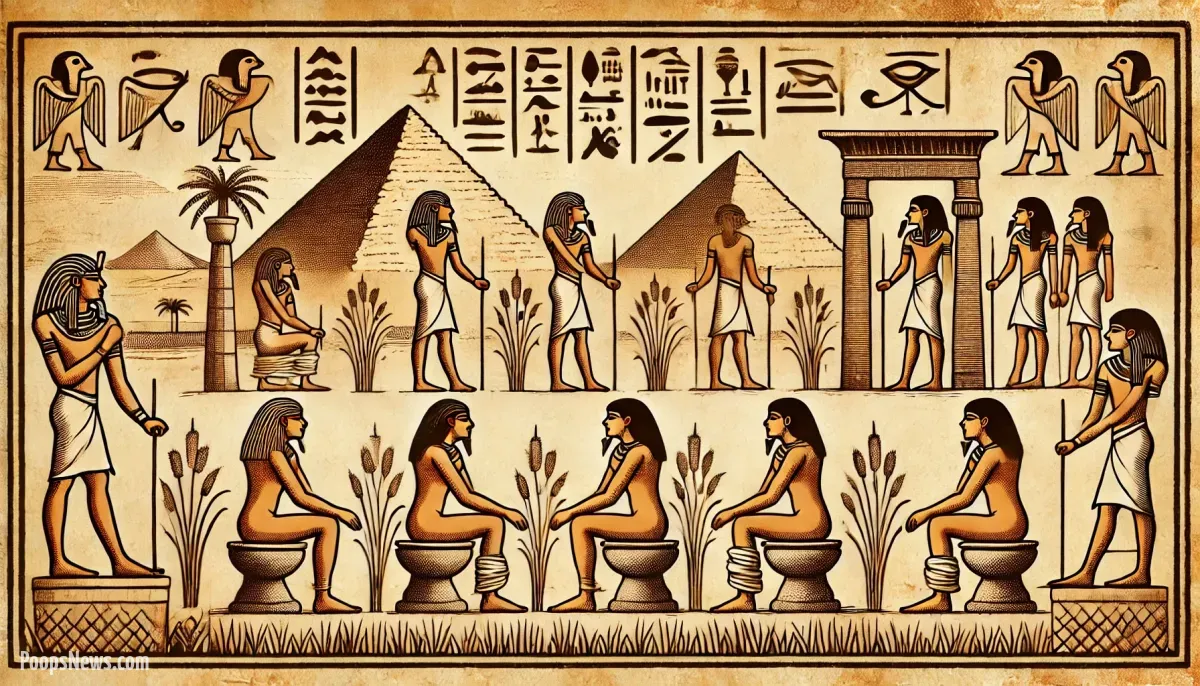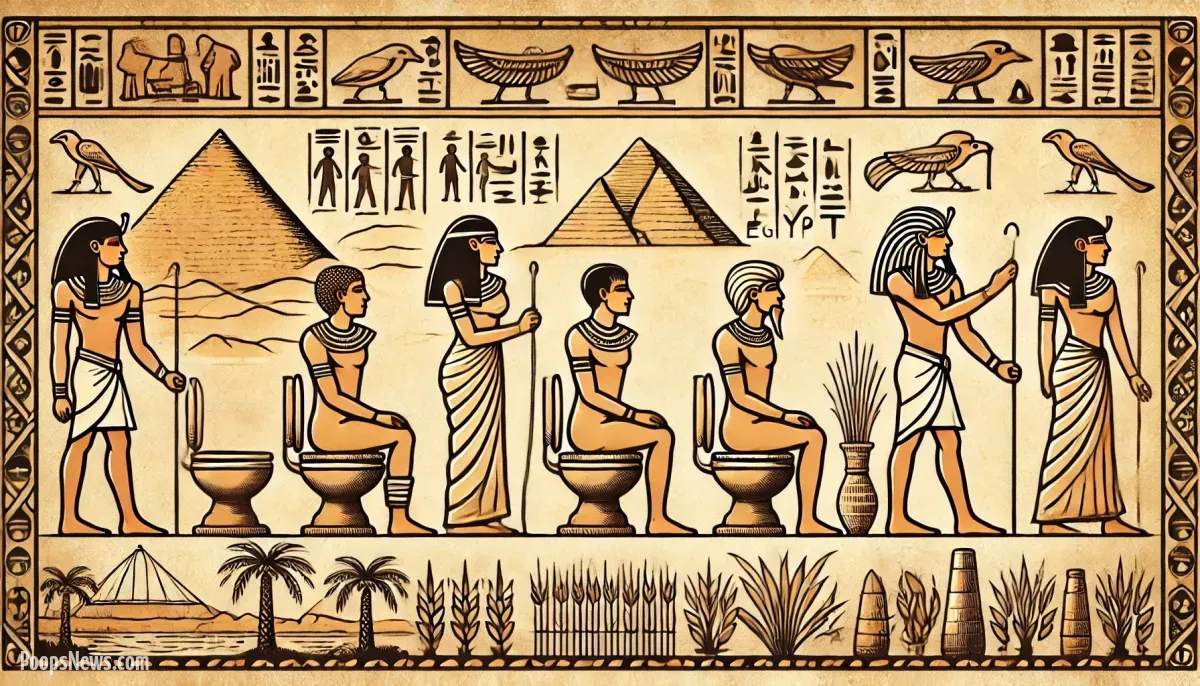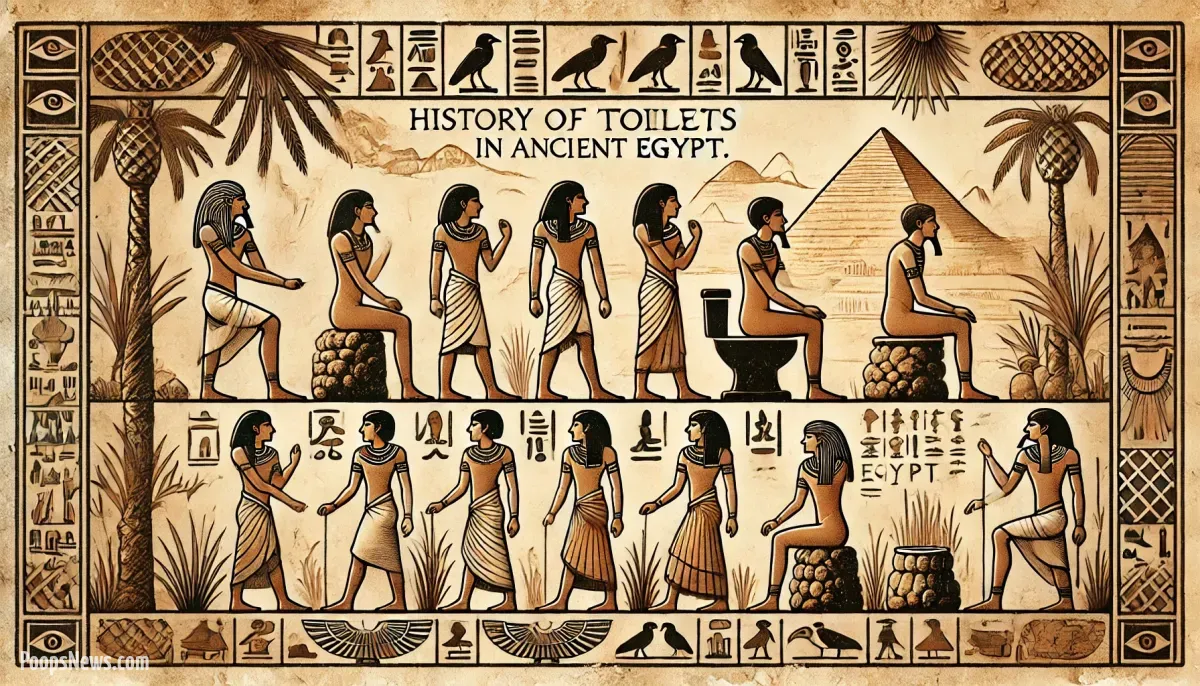The Grand Beginning of Lavatorial Innovation
Long before the pyramids scraped the skies and the Nile seduced the sands, the Egyptians were busy with a much more pressing issue — where to relieve themselves in peace. You see, while the gods demanded towering monuments, human biology had far humbler requests. But in Ancient Egypt, no task was too small, no issue too trivial, and thus, the glorious journey of lavatorial invention began.
While the rest of the world thought it was enough to squat behind a tree, the Egyptians, forward-thinking geniuses that they were, sought to elevate the experience of answering nature’s call. Some argue that the reason for the Sphinx’s permanently perplexed expression is less about ancient mysteries and more about it observing the world’s first toilet being installed just beneath its stone paws.
Pharaohs and Their Porcelain Thrones
Let’s dive deep into the daily struggles of a typical pharaoh. While most historians focus on tombs, chariots, and the endless procession of pyramid construction, few realize that the real symbol of pharaonic power lay not in the crown but in the porcelain throne. That’s right, folks. Ancient Egyptians weren’t just pioneers of agriculture, architecture, and eyeliner; they were also the proud inventors of toilet envy.
The royal lavatory, often confused with treasure chambers by modern-day archeologists, was a status symbol unlike any other. The higher the throne (both metaphorically and literally), the more power one commanded. Royal restrooms were adorned with golden toilet brushes, hieroglyphic toilet paper (imagine deciphering that!), and, of course, stone seats meticulously sculpted by the finest artisans. A pharaoh wouldn’t dare lower themselves to the common clay pots used by the hoi polloi. Oh no, their rear deserved the best marble that could be found — and if there was one thing the Egyptians were never short on, it was stone.

Hieroglyphs of Relief: Early Toilet Design
Most hieroglyphs depict grand ceremonies, royal decrees, or stories of gods. However, hidden among the majestic imagery of falcons, sun gods, and flowing rivers, there exists a little-known hieroglyphic series affectionately called “The Book of the Rear”. These stone carvings document humanity’s first organized attempt at public sanitation. True pioneers of their time, the Egyptians developed a sewage system that could easily make modern-day plumbers blush with jealousy.
Ancient Egyptian toilets were far from simple pits in the ground; these were lavish structures designed with an artisan’s flair. Think of it as the ancient world’s answer to today’s smart toilets: sleek, efficient, and with just the right amount of flair. They didn’t flush, but they certainly didn’t need to. When your entire sewage system is the Nile, who needs a handle?
The Nile’s Unsung Role: Nature’s Flush
Speaking of the Nile, this mighty river was more than just a source of life for crops and civilization. It was also, arguably, the world’s first giant communal flush system. When the seasonal floods came, the Egyptians didn’t just celebrate the replenishing of their fertile lands; they also relished in the natural cleansing of their toilet systems. Yes, indeed, one could argue that the ancient Egyptians invented the concept of a ‘natural’ bidet.
The Nile’s flow, much like the modern toilet, ensured that what went down, well… flowed downstream. They may not have had modern plumbing, but when nature provides an annual flush cycle, why overcomplicate things? Of course, there were some downsides, such as the occasional Nile crocodile mistaking a squat for a snack, but these were the minor inconveniences that came with innovation.
Temple Toilets: Divine Restrooms or Just Practicality?
Temples in Ancient Egypt weren’t just places of worship — they were bustling hubs of life, commerce, and surprisingly, toilet breaks. You see, when you’re spending the entire day carving tribute to Ra or endlessly polishing Osiris statues, you’re going to need a restroom at some point. Contrary to popular belief, these sacred spaces were also equipped with elaborate toilet facilities, so that even the priests could enjoy a moment of divine relief.
Archeologists have found evidence of these ‘temple toilets,’ which were ingeniously hidden behind secret walls. No ordinary layperson was allowed to witness the sacred act of ‘purification,’ as it was deemed a privilege of the priesthood. However, modern research suggests that what was once thought to be spiritual preparation may have just been priests sneaking off for a quick break behind the altar.
The question of whether the gods themselves used these facilities is, of course, hotly debated among Egyptologists. Some argue that Anubis had no need for a restroom break, while others believe that the absence of celestial toilets in mythology might simply be due to a lack of surviving documentation. Alas, some mysteries remain eternally unresolved.
Papyrus Predicaments: The Original Toilet Paper
One cannot explore Ancient Egypt’s lavatorial history without addressing the burning question: what did they use to wipe? In a time before two-ply comfort, the Egyptians turned to the humble papyrus plant. Papyrus, the multi-purpose wonder plant, wasn’t just for scrolls and artwork — it was also an early predecessor to toilet paper. Egyptians carefully peeled layers of papyrus to craft a textured, yet effective, wiping mechanism. Sure, it wasn’t Charmin-soft, but it did the job.
Of course, papyrus was reserved for the elite. For the less fortunate, alternatives included leaves, stones, or, in more desperate times, the ancient equivalent of today’s dreaded ‘empty roll’: bare hands. Some historians theorize that this very predicament is what led to the rise of public handwashing practices, making the Egyptians the unsung heroes of ancient hygiene.

Lavatory Gods: Deities of the Dung
While most are familiar with the more prominent gods of the Egyptian pantheon — like Ra, the sun god, and Osiris, the god of the underworld — few know about the lesser-known deities that watched over the people in their moments of utmost privacy. Ancient texts make brief mention of “Khepri-Ra”, a scarab-faced god often associated with rebirth and dung beetles (for reasons we dare not question). Could this god have been a divine symbol of transformation… or perhaps something more?
It’s said that Khepri-Ra’s symbol was etched above many lavatories in Ancient Egypt, offering divine protection to those who entered. “May your release be swift, and your burden light”, the blessings would often say, encouraging users to embrace the cyclical nature of life and… other things.
And what of the gods themselves? Did they ever need to “go”? Well, as divine beings, one might assume that such mortal matters were beneath them. But if the number of temple lavatories is any indication, it seems that even the gods had their fair share of earthly needs.
Pyramid Plumbing: The Mysteries of Royal Relieving
When people think of the Great Pyramid of Giza, they marvel at its grandeur, its precision, and its mysterious purpose. What few realize is that the pyramid also houses one of the most enigmatic lavatories known to archaeology. Nestled deep within the maze of chambers lies what experts believe to be Pharaoh Khufu’s personal restroom, a lavishly decorated space that, like everything else in Ancient Egypt, is shrouded in mystery.
Why would a pharaoh need a toilet in his tomb, you might ask? The answer, naturally, lies in the Egyptian belief in the afterlife. You see, death was but a continuation of life, and what’s life without the occasional pit stop? Pharaohs were buried with all the essentials: gold, servants, cats, and, of course, a well-equipped toilet. After all, when you’re embarking on a journey to the afterlife, you never know when nature might call.
Modern-day explorers who venture into these chambers are often struck by the sheer elegance of the facilities. One can only imagine the pharaoh sitting upon his stone throne, gazing out over the afterlife, contemplating both eternity and the pressing matters of digestion.
The Eternal Restroom Break
The legacy of Ancient Egypt is often reduced to grand monuments, towering obelisks, and elaborate burial rites. But to overlook their contributions to the humble toilet would be a grave injustice. These porcelain pioneers laid the groundwork for centuries of bathroom innovation, combining practicality with luxury in ways that even today’s society struggles to replicate.
In the end, while their pyramids may crumble and their hieroglyphs fade, one thing remains clear: the Egyptians knew how to take care of business, both in life and in death. Their toilets were more than mere conveniences — they were symbols of power, comfort, and ingenuity.
So, the next time you find yourself sitting on your modern porcelain throne, take a moment to thank the Egyptians. For without them, who knows where we’d be today? Probably squatting behind a tree, wondering why the Nile doesn’t flow through our backyard.





